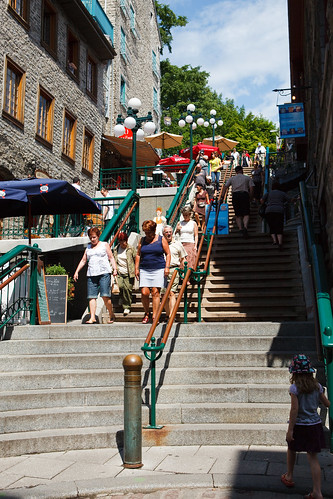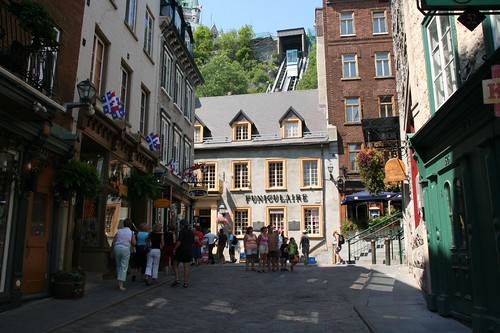What do we call something that both is and is not public transit?
That’s something we’ve wrestled with before (here and here for example), but it wasn’t until a quick trip to Quebec City for an old friend’s wedding (congrats, by the way, to Ingrid and Darren!) that the point was driven home for me.
As many people know, Quebec City is topographically challenging. Which is an understatement if you’re elderly, disabled or otherwise disheartened by the idea of having to traverse an urban area almost exclusively by stairs and hills.
Moving from the upper to the lower parts of the old town, meanwhile, require navigating a series of steep wooden stairways lined with shops and restaurants. It’s all pretty beautiful. But as the stairs crowd with people, the entire experience can get a little overwhelming – and that’s not counting what they must be like in during an icy, slushy and snowy Canadian winter.
The stairs have such a reputation, their original name escalier Champlain (“Champlain Stairs”) has been replaced by the more humorous (and, I suspect, honest) escalier casse-cou – literally, the Breakneck Stairs.
(It’s worth noting that the Breakneck Stairs are just one out of several flights of stairs and hills one needs to ascend/descend to make the trek from the upper to the lower parts of the city. These stairs can present as much of a challenge to pedestrians as the Breaknecks.)
There is, however, another option: The Funiculaire.
Stretching almost exactly from the base of the Breakneck Stairs to to their destination outside the Chateau Frontenac, the Quebec City Funiculaire links the two halves of the city with a convenient, short connection. At only 64m in length, and with an almost completely vertical inclination, this system is more inclined elevator than funicular, but that’s just semantics and not really the point.
The point is this: At a one-way fare of $2.00 CAD (roughly the same in American) the Quebec City Funiculaire isn’t cheap. It’s not something your average joe could afford to use each day in each direction – unless, of course, that was the public transit they required.
Despite having a price point around what most transit agencies charge for unlimited access to their entire network, riders of the Funiculaire receive a five-minute long lineup to take a 30-second un-air-conditioned (at least when I rode it) elevator ride. It took less time for me to walk the stairways than it took to wait and ride the funicular.
Yet there were no shortage of people willing to use it. Most, I’m certain, were tourists, but many were not. And there appeared to be equal traffic in both the ascending and descending directions – something I admittedly didn’t expect.
So what do we call this piece of infrastructure? Especially when on considers issues of the mobility-challenged, the funicular clearly serves a public transit a purpose. Yet still, it exists outside the realm of public transit. It occupies a grey area that isn’t easy to define – and even harder to price.
These kind of borderline systems – whether cable-propelled or not – are common throughout the world. And despite this, we still don’t have a name for these type of installations. So I’m proposing we name them Grey Public Transit Systems.
Grey Public Transit Systems are neither the white of public transit systems nor the black of private transit (or reversed if you so choose) – instead they exist on a spectrum where they straddle both worlds and add an essential mix to the urban mobility picture.
What do people think? Does the term work? Does it make sense?



1 Comment
If it were owned and operated by the municipality, then it’d be considered public transit. Otherwise, it should be considered private transport.